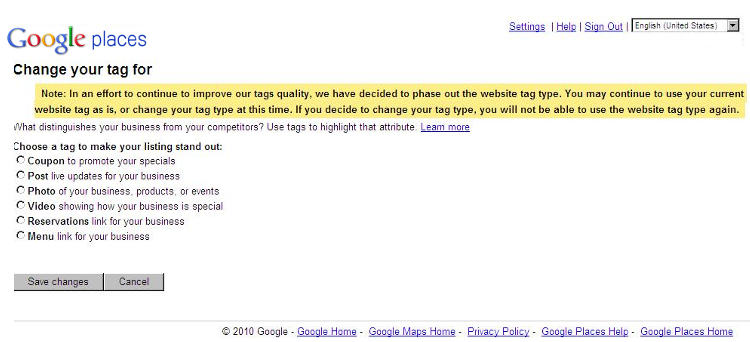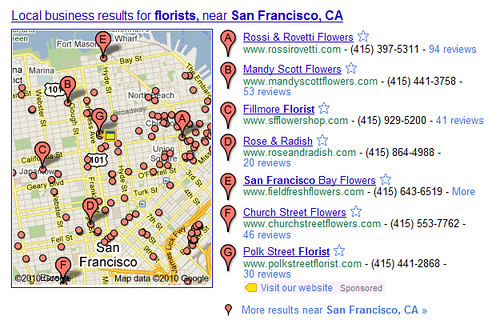Google’s phasing out site link option from Tag Ads – just nine months after introducing the Tag ads for Maps and local search, Google has apparently decided to do away with the option to link your Tag directly to your website. One of my contacts sent this screengrab to me showing within Google Places they are now being asked to switch to a different ad type:
If you currently have a Tag Ad linked to your site, I’d guess that you have until the end of whatever time you’ve contracted before you’ll be forced to switch to a different option.
The folks who sent this to me supposed that this was being done in sync with the recent announcement of a new ad type, Google Boost. However, that doesn’t entirely explain why the rapid switcharoo.
Here’s my guess – I think there were two main reasons the website option is being phased out. First, as part of Usability testing, I would guess that Google has discovered that in the cases where the Tag links to the website, it may’ve reduced clickthroughs for their own natural/organic links to the business. The business’s name is typically hyperlinked to the business website from Maps listings in the 10-pack, and perhaps Google was concerned that the ad was changing user behavior, reducing the time and clicks users spend staying inside Google interfaces.
Secondly, perhaps they believed this was an opportune time to push a local variation of their Sponsored Links / Google AdWords — a.k.a. “Google Boost” — and early testing likely indicated that until or if the 10-packs become saturated with Tag Ads, the website link option would’ve cannibalized the potential sales of Boost. They state that if you have a Tag Ad, it can appear within the Boost ad along with other organic listing features such as blue map “pins” and reviews.
Unfortunately, I believe that most small businesses will now interpret the change as Google squeezing them for more money. It’s not hard to see that the mere existence of the Boost ads do not necessitate revocation of the website option in Tags. If Google has done this out of the motives I’ve supposed above — manipulation of user behavior to keep people within the Google silo longer and to further drive up sales of Google Boost ads — then businesses can only be left to feel left rather at the mercy of the big kid on the block.
From an advertiser’s perspective, those who were using the website option will likely feel really irked that they cannot now send clicks directly to their site for the ad dollars they’re spending. This will appear to be a major reduction in the efficiency of the advertising vehicle. Being forced to switch to ad options which may only keep potential customers in Google’s interface longer will appear needlessly self-serving of Google, at the expense of the advertiser.
Just from anecdotal searches I’ve done and my own gut-sense, I would venture to guess that a major chunk of Tag advertisers used the website option.
Here’s what’s missing (and has been missing from Google Maps development for a while): input from the advertisers and small businesses. Those of us who provide local search marketing have noted for some time now a complete lack of representation of SMBs’ interests in Google’s ongoing development in Local — an omission of a significantly large demographic of consumers/stakeholders who use and interact with Google Maps and Google Places every day. The lack of communication behind such changes leaves Google open to very skeptical interpretations.
Frankly, for a company so devoted to Usability and User Experience, it mystifies me as to why they do not incorporate SMBs in their development process as a major demographic component of their users.
Tags: Google Boost, Google Places, Google Tag Ads, Google Tags, Tag Ads, Usability, User Experience





 ShareThis
ShareThis
I was up there with you until the first part of the last sentence. Google, in my opinion, has not been about user experience and usability in a long time. They’ve been about Adwords forever. Remember when Google increased the staffing in maps/places? When they added sponsored links inside the business pages. If Google had been about the user then, why would they add competitors ads inside your own listing? No, this is simply Google saying, we make more money by not letting the user go straight to the website, so we’re going to send them to another ad infested page.
I think they perceive the Sponsored Links inside Place pages virtually the same as their “Related Places” section in them. Related places are arguably positive for endusers — it lays out a list of other companies which might be similar to the one they’re looking at — although it’s obviously quite negative for businesses.
I think they’re still about user experience aspects, but their experimentations in ads and self-service interfaces really should be tested on advertisers as well.
There is maybe some research out there which indicates that consumer interactions via video views and such could increase likelihood of conversions. But, Google’s not really even testing conversion rates with these moves.
I try to apply a neutral assessment of what Google may be doing with any given action, but I tend to side with you on this — this helps Google’s profit goals and increases user visit time, while it negatively impacts advertisers. It’s very hard to interpret this in any other light.